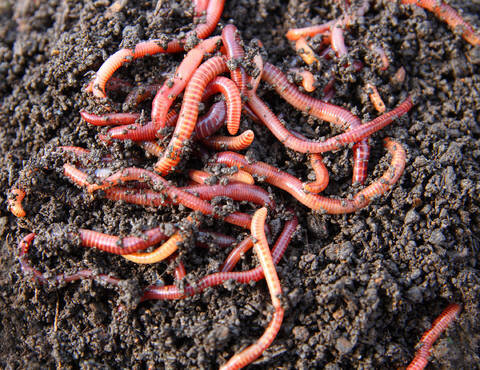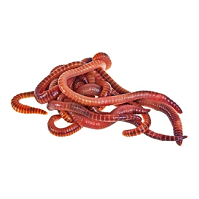Energetic red wigglers: Expand your worm farm
Energetic red wigglers: Expand your worm farm
Blog Article
The Function of Red Wigglers in Sustainable Horticulture
The assimilation of red wigglers into sustainable gardening practices supplies an engaging technique to boosting dirt health and wellness and minimizing natural waste. The ramifications of utilizing red wigglers prolong beyond mere composting; their duty in forming an extra sustainable future warrants a much deeper expedition of their benefits and sensible applications.
Recognizing Red Wigglers
Red wigglers, scientifically referred to as Eisenia fetida, are a varieties of earthworm renowned for their duty in lasting horticulture and composting practices - red wigglers. These worms grow in decaying raw material, making them especially reliable in transforming kitchen area scraps and yard waste right into nutrient-rich garden compost. Unlike standard earthworms, red wigglers have a higher tolerance for varying wetness levels and can prosper in atmospheres with plentiful natural product
(red worms)Typically, red wigglers are smaller sized than their earthworm equivalents, generally determining in between 3 to 4 inches in size. They have a reddish-brown coloration and have a fractional body framework that aids in their burrowing and feeding activities. These microorganisms are hermaphroditic, suggesting each specific has both male and women reproductive organs, which permits for effective population growth under optimal problems.
The habitat choices of red wigglers consist of wet, dark settings abundant in organic web content, such as garden compost containers or worm farms. Their environmental role extends past composting; they are indispensable in freshening the soil and facilitating nutrient biking, which inevitably adds to much healthier garden ecosystems. red wigglers. Recognizing the biology and behavior of red wigglers is crucial for those seeking to carry out efficient vermicomposting in lasting gardening
Advantages of Vermicomposting
Vermicomposting offers many benefits that enhance lasting gardening techniques and add to environmental health and wellness. Among the main advantages is the change of natural waste right into nutrient-rich garden compost, which improves dirt structure and fertility. The spreadings produced by red wigglers are packed with advantageous microorganisms and necessary nutrients, making them an outstanding natural plant food.
In addition, vermicomposting substantially lowers garbage dump waste. By drawing away kitchen scraps and lawn waste from landfills, this practice not just minimizes methane exhausts-- a potent greenhouse gas-- however likewise promotes a round economy, where waste is repurposed as a source.
One more benefit is the enhancement of soil oygenation and water drainage (red wigglers). The burrowing activity of red wigglers creates channels in the dirt, allowing air and water to permeate even more easily, thus cultivating a much healthier origin system for plants
Moreover, vermicomposting can be done on a little range, making it obtainable for city gardeners and those with restricted space. This approach motivates ecological stewardship and recognition, as individuals come to be more engaged with their waste administration practices. Eventually, vermicomposting represents a sustainable, effective, and environmentally friendly strategy to horticulture that benefits both plants and the earth.
Exactly How to Start Vermicomposting
Beginning your very own vermicomposting system can be a rewarding endeavor that boosts your lasting horticulture practices. To begin, select an appropriate container, such as a plastic container or wood box, with great drain and air flow. The size will depend upon the quantity of kitchen scraps you produce; a container of 10-14 gallons generally suffices for a house.
Following, prepare the bed linens product. Shredded newspaper, cardboard, and coconut coir are exceptional alternatives, providing a comfy habitat for the red wigglers. Aim for a bed linen deepness of regarding 4-6 inches, which must be moist but not soaked.
Once the bedding is developed, introduce your worms. Red wigglers (Eisenia fetida) are one of the most ideal for composting. Beginning with roughly one extra pound of worms for every single 2-3 extra pounds of kitchen area scraps weekly.
Begin adding kitchen waste, staying clear of meat, dairy products, and oily foods, as these can attract pests and develop odors. Consistently keep track of the container's dampness levels and temperature level, guaranteeing it remains within the perfect array for worm task. With these first actions, you'll be well on your way to creating nutrient-rich compost for your garden.
Preserving a Healthy Worm Bin
A growing worm bin requires regular treatment and interest to maintain an ideal environment for the red wigglers. Key elements to monitor include dampness levels, temperature, and food supply. Preserving a dampness level comparable to a wrung-out sponge is crucial; excessive water can cause anaerobic conditions, while insufficient can dry out the worms.
Temperature is likewise important, as red wigglers prosper in a series of 55 to 77 levels Fahrenheit. Extreme temperatures can worry the worms, possibly bring about mortality. Placing the bin in a climate-controlled location or utilizing protecting products can help manage temperature changes.

Lastly, aeration is crucial. On a regular basis transforming the bed linens and making use of a fork or shovel can avoid compaction and promote airflow, making sure a healthy, flourishing atmosphere for the red wigglers. By sticking to these methods, gardeners can preserve an effective worm bin that supports lasting horticulture efforts.
Effect on Soil Wellness
Enhancing soil health with the usage of red wigglers is a basic aspect of sustainable gardening. By eating organic matter, red wigglers damage down complex products right into less complex substances, a process understood as vermicomposting.

(red wiggler worms)Studies have actually shown that soils enhanced with worm castings display boosted microbial task and improved fertility, bring about greater plant returns. By integrating red wigglers right into horticulture methods, garden enthusiasts not just improve their dirt however also contribute to a much more sustainable agricultural system, highlighting the interconnectedness browse around here of dirt health and environmental stewardship.

Conclusion
Finally, red wigglers significantly add to sustainable horticulture through their efficient vermicomposting techniques. Their capability to transform natural waste into nutrient-rich compost improves soil fertility and sustains a diverse microbial ecosystem. Their burrowing activity boosts dirt oygenation and water retention, benefiting plant wellness. By advertising waste decrease and promoting a circular economy, red wigglers become important components in environment-friendly horticulture initiatives, emphasizing their crucial function in environmental sustainability.
Report this page